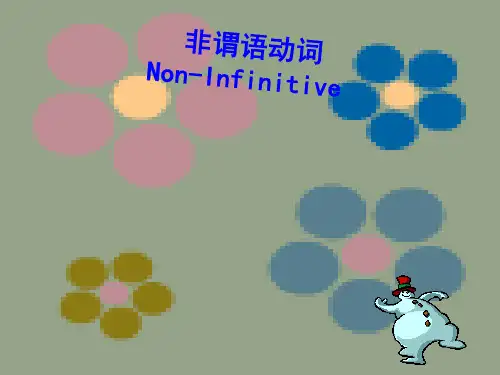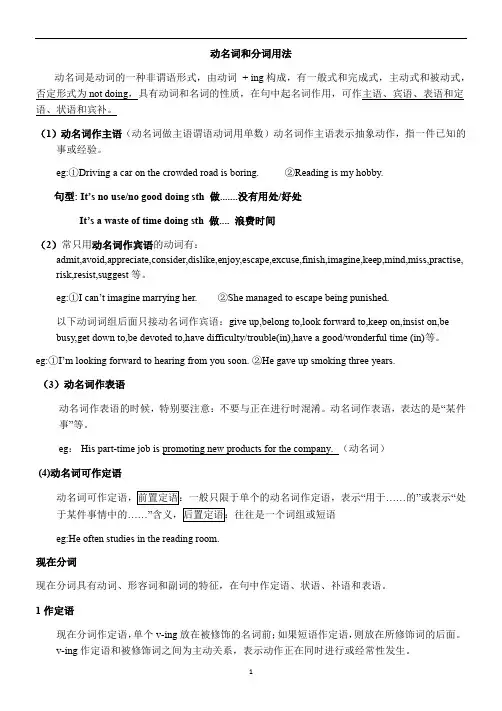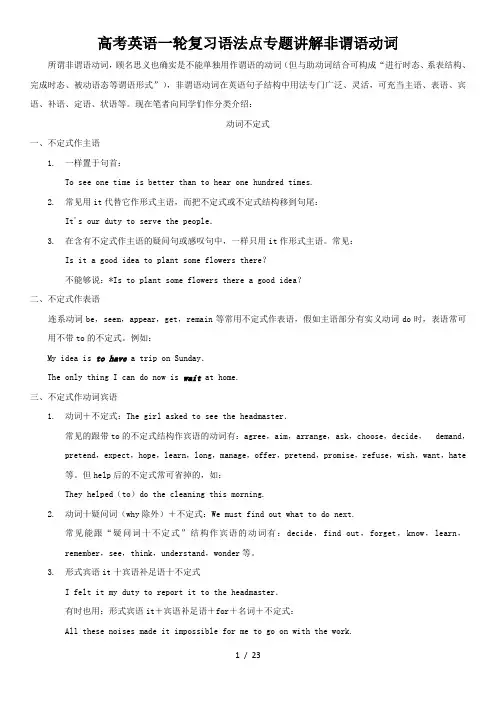2017年高考英语一轮复习--语法专题-第八讲-非谓语动词-新人教版
- 格式:doc
- 大小:362.50 KB
- 文档页数:12





非谓语动词是中学英语语法的重点和难点,也是高考热点之一。
主要考查非谓语动词作状语、定语和宾语补足语的用法。
考点一非谓语动词作定语1.动词不定式作定语动词不定式作定语常表示该动作尚未发生,即动词不定式具备将来含义。
He has a lot of work to do.他有很多工作要做。
He has something good enough to reaD.他有很好的读物。
动词不定式既可用主动式也可用被动式,但其含义有所不同。
试比较:Do you have anything to send?(动作的执行者是“你”)Do you have anything to be sent?(动作的执行者是“我”或“别人”)。
2.动词—ing形式作定语当该动词与被修饰的名词之间为主动关系或用来表示被修饰词的用途时,用动词—ing形式。
Three days later I received a letter offering me the joB.三天后,我收到了一封给我提供这份工作的信。
This is a reading room.这是一个阅览室。
3.过去分词作定语过去分词作定语,被修饰的名词与分词在逻辑上通常是被动关系。
过去分词作定语也可表示完成。
Tsinghua University,founded in 1911,is home to a great number of outstanding figures.清华大学建立于19,是许多杰出人物的摇篮。
This is a book written by a famous Chinese writer.这是一本由一位著名的中国作家写的书。
考点二非谓语动词作状语1.动词不定式作状语,表示目的、原因、结果等。
She came here to work.她来这儿是为了工作。
I’m glad to hear the news.听到这个消息我非常高兴。
He lifted a stone only to drop it on his own feet.他搬起石头结果砸了自己的脚。


动名词和分词用法动名词是动词的一种非谓语形式,由动词+ ing构成,有一般式和完成式,主动式和被动式,否定形式为not doing,具有动词和名词的性质,在句中起名词作用,可作主语、宾语、表语和定语、状语和宾补。
(1)动名词作主语(动名词做主语谓语动词用单数)动名词作主语表示抽象动作,指一件已知的事或经验。
eg:①Driving a car on the crowded road is boring. ②Reading is my hobby.句型: It’s no use/no good doing sth 做.......没有用处/好处It’s a waste of time doing sth 做.... 浪费时间(2)常只用动名词作宾语的动词有:admit,avoid,appreciate,consider,dislike,enjoy,escape,excuse,finish,imagine,keep,mind,miss,practise, risk,resist,suggest等。
eg:①I can’t imagine marrying her. ②She managed to escape being punished.以下动词词组后面只接动名词作宾语:give up,belong to,look forward to,keep on,insist on,be busy,get down to,be devoted to,have difficulty/trouble(in),have a good/wonderful time (in)等。
eg:①I’m looking forward to hearing from you soon. ②He gave up smoking three years.(3)动名词作表语动名词作表语的时候,特别要注意:不要与正在进行时混淆。
动名词作表语,表达的是“某件事”等。



高考英语一轮复习语法点专题讲解非谓语动词所谓非谓语动词,顾名思义也确实是不能单独用作谓语的动词(但与助动词结合可构成“进行时态、系表结构、完成时态、被动语态等谓语形式”),非谓语动词在英语句子结构中用法专门广泛、灵活,可充当主语、表语、宾语、补语、定语、状语等。
现在笔者向同学们作分类介绍:动词不定式一、不定式作主语1.一样置于句首:To see one time is better than to hear one hundred times.2.常见用it代替它作形式主语,而把不定式或不定式结构移到句尾:It's our duty to serve the people.3.在含有不定式作主语的疑问句或感叹句中,一样只用it作形式主语。
常见:Is it a good idea to plant some flowers there?不能够说:*Is to plant some flowers there a good idea?二、不定式作表语连系动词be,seem,appear,get,remain等常用不定式作表语,假如主语部分有实义动词do时,表语常可用不带to的不定式。
例如:My idea is to have a trip on Sunday.The only thing I can do now is wait at home.三、不定式作动词宾语1.动词+不定式:The girl asked to see the headmaster.常见的跟带to的不定式结构作宾语的动词有:agree,aim,arrange,ask,choose,decide, demand,pretend,expect,hope,learn,long,manage,offer,pretend,promise,refuse,wish,want,hate 等。
但help后的不定式常可省掉的,如:They helped(to)do the cleaning this morning.2.动词十疑问词(why除外)+不定式:We must find out what to do next.常见能跟“疑问词十不定式”结构作宾语的动词有:decide,find out,forget,know,learn,remember,see,think,understand,wonder等。
第八讲非谓语动词非谓语动词考点透析1.不定式、分词、动名词的否定式都是在其前面加 not/never。
如:(1)Mrs.Smith warned her daughter never to drive after drinking.史密斯夫人提醒女儿不要酒后开车。
(2)Not knowing what to do,I went to the teacher for advice.由于不知道该怎么办,我去问老师有何建议。
(3)I apologize to you for not telling you the truth immediately.我没有立刻告诉你真相,向你道歉。
2.不定式的进行时表示动作与谓语动作同时发生。
不定式、分词、动名词的完成式表示动作在谓语之前发生。
如:(1)When mother came into the room,Tom pretended to be working hard at his lessons.妈妈走进房间时,汤姆装作正在认真做功课。
(2)Robert is said to have studied abroad,but I don't know what country he studied in.据说罗伯特到国外留过学,不过我不知道他在哪个国家学习过。
(3)Having finished all my homework,I went out to play football with Li Ming.在完成所有的作业后,我和李明去踢足球了。
(4)The boy was severely punished by his father for having told lies.这男孩因说谎受到他父亲严厉的惩罚。
3.不定式作定语时,如果不定式是不及物动词,或者不定式所修饰的名词是不定式动作的工具、地点,不定式后就应有必要的介词。
如:There are five pairs to choose from,but I'm at a loss which to buy.有五对可供选择,可我不知道该买哪一对。
4.不定式主动表被动的几种情况:在 There be结构中,作定语的不定式既可用主动语态也可用被动语态。
如:There is a lot of work to do/to be done.有许多工作要做。
不定式作定语时,如果不定式所修饰的名词是不定式的宾语,但是又可在句子中找到另一个词作不定式的逻辑主语,不定式要用主动语态。
如:Would you please give the boy something to read?请给这男孩一些读物好吗?(something是 read的宾语,the boy是 read的逻辑主语,不定式用主动语态)注意比较下列两个句子:I have some letters to type.我有一些信要打印。
(隐含意义:I'll type the letters myself.)Do you have any letters to be typed,sir?先生,你有信件要我打印吗?(隐含意义:I'll type the letters for you.)5.关于不定式的省略。
在连词than,as后,介词except,but,besides后,如果前有实义动词do的某种形式,动词不定式一般不带to,反之则带to。
如:(1)In that case,there is nothing you can do than wait.既然如此,没有办法,你只能等了。
(2)He likes reading novels besides to play the piano.除了弹钢琴,他还喜欢看小说。
使役动词make,let,have和感官动词see,watch,hear,observe后接不定式作宾补时要省略to,但在被动语态中,to不能省略。
如:(1)A computer does only what thinking people have it do.电脑只能做有思维的人类要它做的事情。
(2)Paul doesn't have to be made to learn.He always works hard.鲍尔不用被迫学习,他一向学习努力。
6.admit,advise,avoid,appreciate,can't help,consider,delay,deny,escape,enjoy,finish,feel like,fancy,imagine,mind,miss,practise,risk,suggest等动词以及所有带介词的短语动词后面只能跟动名词作宾语。
如:(1)I really appreciate having time to relax with you on this nice island.有时间与你在这个美丽的岛上放松一下,我真的非常感激。
(2)The boy was lucky enough to escape being punished.这孩子很幸运地逃过了处罚。
7.remember,forget,try,mean,regret,stop,go on后接不定式做宾语与接动名词作宾语,意义有很大区别,必须牢记。
regret doing 因做过某事而后悔,动作已发生regret to do 因将做某事而遗憾,动作没发生remember doing 记得做过某事,动作已发生remember to do 记得去做某事,动作没发生forget doing 忘记曾做过某事,动作已发生forget to do 忘记做某事,动作没发生mean doing 意味着mean to do 打算做stop doing 停止做stop to do 停止做某事而做另一件事try doing 尝试做try to do 努力做如:(1)She searched the top of the hill and stopped to rest on a big rock by the side of the path.她扫视了一眼山顶,在路边的一块大岩石旁停下来休息。
(2)-You were brave enough to raise objections at the meeting.——你真勇敢,在会上提出了反对意见。
-Well,now I regret having done that.——哎!我现在正后悔那样做!(3)-I usually go there by train.——我通常坐火车去那儿。
-Why not try going by boat for a change?——为什么不改变一下,试试坐船呢?(4)Mastering a foreign language doesn't mean learning it in class only.要掌握一门外语并不意味着只在课堂上学习就行。
8.look forward to,devote oneself to,pay attention to,stick to,devote to,make contributions to,be used to,get used to,object to中的to是介词,因而其后接动名词作宾语,不要误用动词不定式。
(1)I'm looking forward to seeing you again.我盼望再次看到你。
(2)Mr.Reed made up his mind to devote all he had to setting up some schools for poor children.里德先生决心倾其所有为贫穷孩子建几所学校。
9.在“There is no+主语” 句型中,常用动名词作主语。
(1)There is no telling what will happen in the future.很难说未来会发生什么。
(There is no telling...=It is impossible to tell...)(2)There is no denying that he plotted this rebellion.无可否认,他策划了这次谋反。
10.关于being+过去分词。
“being+过去分词”是分词一般式的被动语态,常用作定语,表示一个正在进行的被动动作。
分词短语作状语时,如要表示一个被动动作,用过去分词即可,因为过去分词本身就可表被动,一般不能用being+过去分词。
只有当分词表示一个正在进行而且又是被动的动作时,才可用being+done (这种用法很少见)。
(1)Founded in 1636,Harvard is one of the most famous universities in the United States.哈佛大学建于1636年,是美国最著名的大学之一。
(不用being founded)(2)The house being built in our school is for us teachers.Though there's noise most of the day we still feel happy about it.学校正在修建的那栋房子是给我们教师建的,虽然一天到晚有噪音,我们还是很高兴。
(being built是定语,“正在被修建的”)(3)Translated into English,the sentence was found to have a completely different word order.这个句子译成英语后,词序完全不同了。
(不用being translated)11.关于分词选定的原则。
分词短语作定语时,分词的选定依据分词与被其修饰的名词的关系而定。
如果名词是分词动作的执行者,用现在分词;如果名词是分词动作的承受者,用过去分词。
分词短语作状语时,则要看分词与句子主语的关系。
如果句子的主语是分词动作的执行者,用现在分词;如果主语是分词动作的承受者,用过去分词。
(1)Seen from the mountain,the city looks beautiful.从山顶看去,这个城市显得非常美丽。
(2)Seeing from the mountain,we can see the river running through the city.从山顶看去,我们可以看到一条河流经整个城市。
(第一句:the city“被看”,用过去分词;第二句:“我们看”,表主动,用现在分词)(3)The computer center,opened last year,is really popular among the students in this school.去年开放的电脑中心深受本校学生的欢迎。